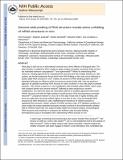Genome-wide probing of RNA structure reveals active unfolding of mRNA structures in vivo
Author(s)
Rouskin, Silvi; Zubradt, Meghan; Washietl, Stefan; Kellis, Manolis; Weissman, Jonathan S.
DownloadKellis_Genome-wide.pdf (8.019Mb)
OPEN_ACCESS_POLICY
Open Access Policy
Creative Commons Attribution-Noncommercial-Share Alike
Terms of use
Metadata
Show full item recordAbstract
RNA has a dual role as an informational molecule and a direct effector of biological tasks. The latter function is enabled by RNA’s ability to adopt complex secondary and tertiary folds and thus has motivated extensive computational and experimental efforts for determining RNA structures. Existing approaches for evaluating RNA structure have been largely limited to in vitro systems, yet the thermodynamic forces which drive RNA folding in vitro may not be sufficient to predict stable RNA structures in vivo. Indeed, the presence of RNA-binding proteins and ATP-dependent helicases can influence which structures are present inside cells. Here we present an approach for globally monitoring RNA structure in native conditions in vivo with single-nucleotide precision. This method is based on in vivo modification with dimethyl sulphate (DMS), which reacts with unpaired adenine and cytosine residues, followed by deep sequencing to monitor modifications. Our data from yeast and mammalian cells are in excellent agreement with known messenger RNA structures and with the high-resolution crystal structure of the Saccharomyces cerevisiae ribosome. Comparison between in vivo and in vitro data reveals that in rapidly dividing cells there are vastly fewer structured mRNA regions in vivo than in vitro. Even thermostable RNA structures are often denatured in cells, highlighting the importance of cellular processes in regulating RNA structure. Indeed, analysis of mRNA structure under ATP-depleted conditions in yeast shows that energy-dependent processes strongly contribute to the predominantly unfolded state of mRNAs inside cells. Our studies broadly enable the functional analysis of physiological RNA structures and reveal that, in contrast to the Anfinsen view of protein folding whereby the structure formed is the most thermodynamically favourable, thermodynamics have an incomplete role in determining mRNA structure in vivo.
Date issued
2013-12Department
Massachusetts Institute of Technology. Computer Science and Artificial Intelligence Laboratory; Massachusetts Institute of Technology. Department of Electrical Engineering and Computer ScienceJournal
Nature
Publisher
Nature Publishing Group
Citation
Rouskin, Silvi, Meghan Zubradt, Stefan Washietl, Manolis Kellis, and Jonathan S. Weissman. “Genome-Wide Probing of RNA Structure Reveals Active Unfolding of mRNA Structures in Vivo.” Nature 505, no. 7485 (December 15, 2013): 701–705.
Version: Author's final manuscript
ISSN
0028-0836
1476-4687